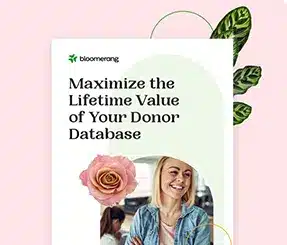From Mission To Message: Designing Marketing Materials That Inspire Action


Full Platform Overview Chat With Us



Full Platform Overview Chat With Us




Marketing outreach is an essential part of advancing a nonprofit’s mission. Strategic and well-thought out print and digital marketing can make an initial connection with a potential donor, strengthen an existing relationship, or inspire an important stakeholder to take action.
Whether the goal is donations, advocacy, or volunteer engagement, well-designed nonprofit marketing and communications can inspire action. But how do you effectively translate your mission into messaging?
The first step is to know your WHY, that is, your mission. What is your organization’s reason for being, and how can that tie into your messaging? For example, if you are a nonprofit that provides mentorship and leadership development for young adults, you can weave in aspects of your brand’s story by highlighting real-life success stories of mentees who have gone on to make an impact. Your messaging can emphasize themes of empowerment, confidence, and community-building, reinforcing your core mission.
Next, determine your WHO—your target audience. Understanding who you are speaking to is just as important as knowing why your organization exists. Most nonprofits have multiple key audiences, each with different needs, motivations, and ways they engage with your mission. Your stakeholders may include donors, volunteers, community members, partners, sponsors, and advocates. By tailoring your messaging, and marketing materials to each audience, you ensure that your organization speaks directly to their interests, needs, and motivations.
For example, when speaking to donors, you may focus on impact and data, demonstrating how their contributions make a measurable difference. On the other hand, when engaging with volunteers, the emphasis shifts to community engagement and relationships, making them feel valued, connected, and inspired to take action.
Remember, your core brand message doesn’t change, but the tone, format and emphasis will shift to align and resonate with each audience. This approach helps your nonprofit build stronger connections and increase engagement without diluting your overall brand identity.
More than 70% of respondents said they’re more likely to donate to a nonprofit that effectively uses storytelling to communicate mission and impact. (Storyraise)
Once you’ve determined your organization’s WHY (reason for being) and WHO (audience), you can start crafting a compelling brand story around it. A well-crafted mission- and impact-driven narrative helps people form an emotional connection with your organization—and that connection leads to donations, volunteering, advocacy, and engagement.
When crafting your message, it’s vital to highlight your WHY—what sets you apart from other organizations. This is the spark that draws people in and ignites interest and engagement—especially with those who are new to your organization.
Trust is essential in nonprofit marketing. Supporters want to know that their contributions are making a difference. And a consistent brand voice throughout your marketing outreach is key to developing this trust. A strong, cohesive voice builds credibility, strengthens relationships, and ensures that your organization is easily recognized—and trusted.
Overall, keep your messaging simple, clear and action oriented. When developing a marketing piece, always ask yourself: What is the ultimate goal? What action do I want people to take?
People are more likely to take action when the message is clear, direct, and impact-focused. For example, instead of saying “Donate now” be more specific with “Donate now and change a life.”
By keeping your messaging focused, compelling, and actionable, you ensure that your audience doesn’t just understand your mission—they are inspired to be part of it.
A Stanford Social Innovation Review study found that nonprofits that tell engaging stories raise twice as much money on average as those that don’t. (Nonprofit Tech for Good)
Next up is the fun part—design. But before you get caught up in the excitement of colors, fonts and visuals, consider how the design will enhance the overall message and ensure the audience engages with your content.
A strong visual hierarchy guides the viewer’s eye and ensures the most important information stands out. Without it, your viewer may feel uncertain, overwhelmed, or confused.
Hierarchy can be established in a layout in a variety of ways including size and scale, typography and weight, color and contrast, and placement and alignment. For example, you may make a headline larger, bold a date and time, call out a button in color, or place an image in a prominent position.
Next, make sure you are using your visual brand consistently. If you have a brand guide, now is the time to use it! It will ensure that you are using your brand colors, logos, graphics, and typography throughout your marketing. A consistent visual identity strengthens your credibility and makes your organization recognizable.
If you plan to adapt a marketing piece across print and digital channels, keep in mind that specifications will vary so you’ll need to adjust the layout and format accordingly. Again, this is a good time to refer to your brand guide for the proper color and logo file formats for the specific channel you are designing for (i.e. CMYK for print and RGB for digital).
Lastly, don’t ignore accessibility and inclusivity. Designing for readability is good practice in general, however you should also consider your audience’s specific needs. For example, websites should be optimized for a variety of viewers, including those who are sight-impaired.
“Design is the silent ambassador of your brand.”
– Paul Rand, American art director and graphic designer
Every marketing piece should tell the viewer what to do next. Including a clear and compelling call to action (CTA) assures that they know what to do next.
In addition to targeted messaging, engaging visuals and graphics can be used to evoke emotion and direct the viewer’s eye to the CTA. Consider the placement and design of your CTA carefully. It should stand out from the rest of the content, drawing attention without being overpowering. Use contrasting colors, larger fonts, and strategic layout positioning to make sure it’s easily noticed.
To further enhance your CTA, think about incorporating interactive elements. Buttons, links, and forms can create a more engaging experience, prompting the viewer to take immediate action. Ensure these elements are user-friendly and optimized for all devices, including mobile phones and tablets.
The language used in CTAs is crucial. Use action-oriented words and phrases that will motivate the audience. Words like “Join Now,” “Donate Today” or “Learn More” can be powerful motivators. You can also tailor the CTA to the desired outcome, i.e. “Help foster cats find a new home.”
Integrating testimonials and success stories near your CTA can also be highly effective. When viewers see positive outcomes from others who have taken the action you’re suggesting, they’re more likely to follow suit. Highlighting real-life stories and impact can make your CTA more compelling and trustworthy.
Lastly, always test and iterate your CTA. Monitor its effectiveness through analytics and feedback, making adjustments as needed to improve its performance.
CTAs surrounded by less clutter and more white space can increase conversion rates by 232%. (VWO)
Testing the effectiveness of your marketing outreach is essential for long-term success. By tracking key performance indicators (KPIs), gathering audience feedback, and testing different strategies, you can fine-tune your approach.
Each marketing effort should have a measurable goal. Depending on the deliverable, you may be tracking audience behavior in email analytics, engagement metrics in social media, completed transactions on your giving page, or website traffic from a QR code or link.
By regularly reviewing these metrics, you can identify trends, strengths, and areas for improvement, allowing you to adjust your strategy accordingly.
Directly asking for feedback from your audience is also important. Surveys can collect specific data about your marketing and demonstrate which channels are effective, as well as the topics that resonate most. One-on-one conversations can help you identify how a donor perceives your brand and marketing outreach. And even casual conversations can be effective, so don’t forget to regularly ask people what they think—and collect and document that data intentionally.
If you’re unsure of your messaging, A/B testing can provide valuable insights into what resonates with your audience. Try different versions of your CTAs, visuals, and messaging to see which ones yield the highest engagement rates or make the strongest connection.
Marketing is not a one-time effort—it’s a cycle of testing, learning, and improving. As you continuously gather feedback and see what is working (or not) you can begin to refine and update your marketing strategy and deliverables to best connect with your audience and meet their needs.
80% of donors are likely to support a nonprofit that shares stories about issues they care about. (Storyraise)
Now that you understand what makes an effective marketing piece, it’s time to apply these principles to your own marketing content. A yearly audit of your marketing materials will highlight any branding inconsistencies, as well as potential gaps or opportunities in your marketing strategy.
I suggest conducting a “Tabletop Audit” by gathering all your print marketing and printing copies of your digital marketing. Spread everything out on a large table and review for brand consistency, in both visuals and messaging. Seeing everything at a glance helps to easily spot inconsistences or gaps in your marketing. This Nonprofit Branding Checklist will help you get started.
And make sure to take detailed notes of your findings and file it with your other marketing data, as well as use it to update your strategic communications plan.
Your brand is more than just a logo—it’s the story you tell and the impact you create. By taking a brand-based strategic approach to your marketing, you can inspire action and build lasting connections with your supporters.
Effective nonprofit marketing isn’t just about looking good. When you combine targeted messaging, engaging visuals, and clear calls to action, you create marketing that not only informs but moves people to get involved.

Comments